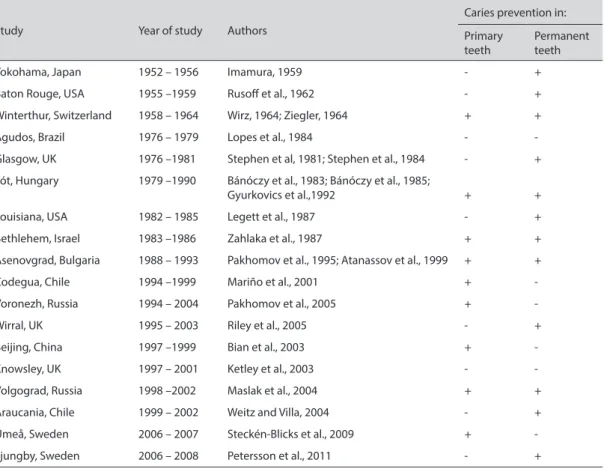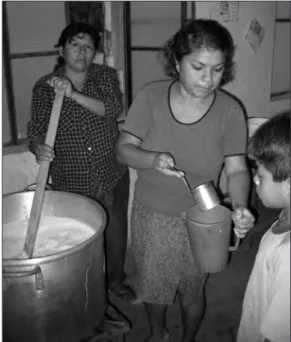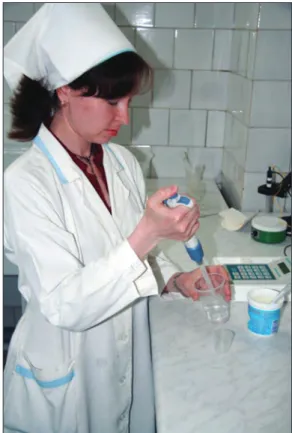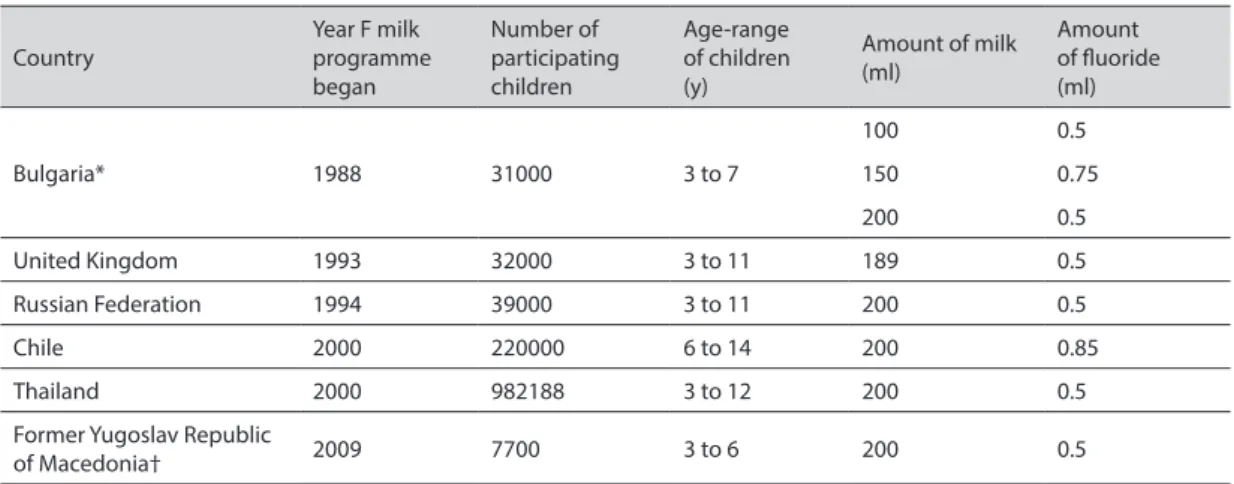¹Department of Oral Biology, Semmelweis University, Budapest, Hungary
²School of Dental Sciences, Newcastle University, UK
3The Borrow Foundation, Padnell Road Waterlooville, Portsmouth, UK
Corresponding author:
Jolán Bánóczy
Semmelweis University of Medicine Department of Oral Biology Nagyvárad ter 4
1089 Budapest Hungary
banoczy.jolan@dent.semmelweis-univ.hu Tel.: + 36 1 303 2436
Fax.: + 36 1 303 2436 Received: 2 November 2012 Accepted: 29 January 2013 Copyright © 2013 by Academy of Sciences and Arts of Bosnia and Herzegovina.
E-mail for permission to publish:
amabih@anubih.ba
Milk fluoridation for the prevention of dental caries
Jolán Bánóczy¹, Andrew Rugg-Gunn², Margaret Woodward3*
DOI: 10.5644/ama2006-124.83
The aim of this review is to give an overview of 55 years experience of milk fluoridation and draw conclusions about the applicability of the method. Fluoridated milk was first investigated in the early 1950s, almost simultaneously in Switzerland, the USA and Japan. Stimu- lated by the favourable results obtained from these early studies, the establishment of The Borrow Dental Milk Foundation (subsequently The Borrow Foundation) in England gave an excellent opportunity for further research, both clinical and non-clinical, and a productive col- laboration with the World Health Organization which began in the early 1980s. Numerous peer-reviewed publications in international journals showed clearly the bioavailability of fluoride in various types of milk. Clinical trials were initiated in the 1980s – some of these can be classed as randomised controlled trials, while most of the clinical studies were community preventive programmes. Conclusion. These evaluations showed clearly that the optimal daily intake of fluoride in milk is effective in preventing dental caries. The amount of fluoride added to milk depends on background fluoride exposure and age of the children: commonly in the range 0.5 to 1.0 mg per day. An advantage of the method is that a precise amount of fluoride can be delivered under controlled conditions. The cost of milk fluoridation programmes is low, about € 2 to 3 per child per year. Fluoridation of milk can be recommended as a caries preventive measure where the fluoride concentration in drinking water is suboptimal, caries expe- rience in children is significant, and there is an existing school milk programme.
Key words: Caries prevention, Fluoride prevention, Milk fluoridation, Caries reduction, Community programmes.
Introduction
The aim of this article is to describe the histo- ry of milk fluoridation and its place in caries prevention. Individual studies have not been referenced in this review as they are listed in the WHO publication ‘Milk fluoridation for the prevention of dental caries’ (1).
Early investigations into fluoridated milk The idea of milk fluoridation emerged, at about the same time, in Japan (1952), in Switzerland (1953) and the USA (1955). Early investigations showed that fluoride added to milk does not change its taste or other char- acteristics, is absorbed well, although slower
* The first two authors are trustees of The Borrow Foundation (Waterlooville, UK) and the third is employed by the organisation as the programme coordinator.
than from fluoridated water. It was consid- ered advantageous that fluoride is added to an important food for infants and small chil- dren, and that consumption of fluoridated milk is not mandatory for everybody, only for those who need it most and agree to receive it. The caries preventive effect of fluoride can even be enhanced by the milk vehicle, due to the cariostatic properties of the mineral, pro- tein and fat content of milk.
The first clinical results were reported by Imamura in 1959, after a five-year study of Yokohama schoolchildren. Milk or soup, containing 2.0 to 2.5 mg sodium fluoride, was consumed at lunch-time, 150 to 180 days per year, by 167 children. Compared with the control group, 29 to 34% caries re- ductions were observed in the permanent dentition. In Baton Rouge, Louisiana, USA, Rusoff and co-workers reported in 1962 on 3.5 years’ results in 129 (65 test and 64 con- trol) children. In children consuming fluori- dated milk at school meals, 35% less caries was recorded than in the control children;
in those who were 6 years old at the begin- ning, the reduction was even larger at 70%.
In Winterthur, Switzerland, Ziegler and Wirz reported a study where 0.22% sodium fluoride solution, prepared by pharmacies in plastic bottles, was added by the parents within the home to milk consumed by chil- dren. Participants were 749 test and 553 control children who were 9 to 44 months old at the start of the programme. In 1964, after six years, caries reductions were 17%
for the deft index (number of decayed, ex- tracted or filled primary teeth) and 30%
for the defs index (number of decayed, ex- tracted or filled primary tooth surfaces) in the primary dentition, and 64% for DMFT (number of decayed, missing or filled per- manent teeth) and 65 for DMFS (number of decayed, missing or filled permanent tooth surfaces) in permanent molars. The propor- tion of caries-free children increased signifi- cantly in the fluoridated milk group.
The Borrow Foundation
The establishment of a charity in England by Edgar Wilfred Borrow (1902-1990) for the promotion of milk fluoridation in order to prevent dental caries in children, brought important progress in the field of research and clinical studies. E.W. Borrow (Figure 1), a wealthy farmer and mechanical engineer in south England, constantly interested in the technical aspects of fluoridation of milk, set up a charity in 1971, named the “Borrow Den- tal Milk Foundation”, for the above purposes.
The aims, summarized in 12 points, were mainly “to promote and support research of fluoridated milk for human consumption by the help of grants, equipment, lectures, scien- tific publications, and to disseminate knowl- edge about this method”. The aims of the orig- inal ‘Trustees’ deed’ were extended in 1993 to include “the support of activities on health promotion and education,… and on healthy nutrition, including milk and milk products”.
Figure 1 Edgar Wilfred Borrow – the founder of “The Borrow Foundation”.
The name of the foundation was changed in 2002 to ‘The Borrow Foundation’ (www.bor- rowfoundation.org). In recognition of his hu- manitarian services, E.W. Borrow received an Honorary Doctorate from Lousiana Univer- sity, USA, in 1983. Two of the authors of this present review are two of the five “Trustees”
of The Borrow Foundation.
The results of clinical and basic research studies, supported by The Borrow Founda- tion, have made the creation and extension of milk fluoridation programmes possible in numerous countries of the world. Based on discussions initiated in the 1980s between The Borrow Foundation and the World Health Organization (WHO), the Bulgarian milk fluoridation programme was initiated, and a ‘Memorandum of Understanding’
was signed by The Foundation and WHO in 1991; this has been renewed every three years. As a result of this collaboration, a book was published in 1996 (2), summariz- ing the studies of basic and clinical research into milk fluoridation, and a revised edition was published in 2009 (1).
Theoretical considerations
Concerning the pathomechanism of fluo- rides, it is accepted that elevated fluoride ion concentrations at the dental plaque/enamel border decrease the rate of demineralisation, increase remineralisation, and reduce acid production of dental plaque. However, the use of milk as a vehicle, generated questions con- cerning possible chemical reactions between milk and fluoride ions, bioavailability of sys- tematically administered fluoride in milk, and interactions involving fluoride in the oral cav- ity (enamel, saliva, plaque and caries).
The results of basic studies on milk fluo- ridation have been published in more than 100 peer-reviewed papers, with increasing frequency in the last 20 years. Based on these studies, according to recent knowledge, the greater part of fluoride added to milk, forms
a soluble complex with the protein frac- tion of milk, from which the fluoride can be liberated in ionic form, so that it is bio- available. The absorption of fluorides with simultaneous food consumption is slower than for fluoride without food, and the pro- portion absorbed depends on the calcium content of the diet. Different types of milk are drunk in communities around the world – whole milk or low-fat milk, fresh, pasteur- ised or sterilised milk, liquid or dried milk.
The bioavailability of added fluoride has been investigated in all of these, on the day of milk processing and after several days’
storage, and shown to be satisfactory.
Because urine is the main vehicle for excre- tion of fluoride, analysis of 24 hour urine ex- cretion is presently the best marker of fluoride intake (3). Recording of fluoride excretion in urine over 24 hours has been recommended before and after introduction of fluoride- based community preventive programmes.
A WHO document, published in 1999, offers detailed guidelines for the method and calcu- lations: based on these, the optimal fluoride concentration in milk and the appropriate in- take of fluoride can be determined.
The systemic effect of fluorides in milk is supported by numerous experimental data.
However, by the 1980s, the opinion as to how fluoride acts to prevent dental caries was go- ing through a change: even with the use of systemic fluoride agents, topical effects were considered more important. The consump- tion of fluoridated milk incorporated into dental enamel inhibited demineralisation and promoted remineralisation. In addition, 30-60 minutes after ingestion of fluoridated milk, both the levels of fluoride in whole sa- liva and dental plaque increase as a conse- quence of the presence of fluoridated milk in the mouth and increased concentrations of fluoride in salivary secretions following the absorption of ingested fluoride. Thus, fluo- ride in milk acts both systemically and topi- cally, in the same way as fluoride in water.
Clinical evaluations
Long-term human studies with fluoridated milk on children, undertaken in about twelve countries have been reported in numerous peer-reviewed papers. Only some of these studies can be classified as RCTs (randomised controlled trials) according to the criteria used in evidence-based medicine; the others can be classed as community-based programmes. In the following paragraphs, the main features of the evaluations of these milk fluoridation pro- grammes in different countries of the world will be summarized, but without the detailed numerical results which can be found in the relevant literature (1, 4, 5) (Table 1).
Scotland: Glasgow
Due to the strong criticism of the early clini- cal studies (for example, small numbers of
participants, lack of baseline examinations, etc.), Stephen and colleagues initiated in Glasgow in 1976, a double blind clinical trial on 4 ½ and 5 ½ year old schoolchil- dren. The group of test children consumed 200 ml milk each school day (about 200 days per year), containing 1.5 mg fluoride, while the control group received plain milk. The results published in 1984, after five years, re- ported a 36% reduction in DMFT and a 48%
reduction in DMFS values for the first per- manent molars which were not yet erupted at baseline in the test group compared with the control group. Fluoride excretion in urine was monitored constantly during the study.
(1) This evaluation (together with the Volgo- grad programme by Maslak: see later) is one of the programmes accepted as an RCT by the Cochrane Centre for Systematic Reviews.
Table 1 List of published reports of studies into the effectiveness of milk fluoridation
Study Year of study Authors
Caries prevention in:
Primary teeth
Permanent teeth
Yokohama, Japan 1952 – 1956 Imamura, 1959 - +
Baton Rouge, USA 1955 –1959 Rusoff et al., 1962 - +
Winterthur, Switzerland 1958 – 1964 Wirz, 1964; Ziegler, 1964 + +
Agudos, Brazil 1976 – 1979 Lopes et al., 1984 - -
Glasgow, UK 1976 –1981 Stephen et al, 1981; Stephen et al., 1984 - +
Fót, Hungary 1979 –1990 Bánóczy et al., 1983; Bánóczy et al., 1985;
Gyurkovics et al.,1992 + +
Louisiana, USA 1982 – 1985 Legett et al., 1987 - +
Bethlehem, Israel 1983 –1986 Zahlaka et al., 1987 + +
Asenovgrad, Bulgaria 1988 – 1993 Pakhomov et al., 1995; Atanassov et al., 1999 + +
Codegua, Chile 1994 –1999 Mariño et al., 2001 + -
Voronezh, Russia 1994 – 2004 Pakhomov et al., 2005 + -
Wirral, UK 1995 – 2003 Riley et al., 2005 - +
Beijing, China 1997 –1999 Bian et al., 2003 + -
Knowsley, UK 1997 – 2001 Ketley et al., 2003 - -
Volgograd, Russia 1998 –2002 Maslak et al., 2004 + +
Araucania, Chile 1999 – 2002 Weitz and Villa, 2004 - +
Umeå, Sweden 2006 – 2007 Steckén-Blicks et al., 2009 + -
Ljungby, Sweden 2006 – 2008 Petersson et al., 2011 - +
Hungary: Fót
In the ‘Children’s City’ of Fót, a milk fluori- dation programme was initiated by Bánóc- zy, Zimmermann and colleagues in 1979, involving about 1000 children aged 2 to18 years (1). The results were published after 2, 3 and 10 years (1982-1992). The children drank for breakfast milk or cocoa, contain- ing 0.4 mg fluoride for kindergarten children and 0.75 mg fluoride for the schoolchildren.
The sodium fluoride solutions were pre- pared by the Pharmacy of Semmelweis Uni- versity in closed glass bottles, then added to the milk in the kitchen of the home, stirred thoroughly for 15 minutes, and consumed within 30 minutes by the children. After five years, in the test group (165) children com- pared with a control group, a considerable caries reduction was observed in both the primary and permanent dentitions. In 7 to 10 year old children, these percentage reduc- tions were 54% in DMFT and 53% in DMFS values. The reduction in the total permanent dentition was 60% for DMFT and 67% for DMFS; the highest reductions were found in the children who had consumed fluoridated milk from 2 to 3 years of age. The difference between the caries prevalence of the test and control groups was, in spite of loss of chil- dren from the study, still statistically signifi- cant after 10 years.
USA: Lousiana, Baton Rouge
In the second Lousiana community pro- gramme, begun in 1982, schoolchildren consumed fluoridated milk, containing co- coa and sugar, for lunch for two or three years. After two years, a significant caries reduction was observed in the permanent dentition: however, due to the loss of chil- dren, three year results could not be evalu- ated (1).The organiser of the experiment, Legett, planned also to establish a research institute for milk fluoridation which, how- ever, could not be realised.
Israel: Bethlehem
Zahlaka and colleagues reported in 1987 the results of a study on 273 children who were aged 4 to 7 years at baseline and who had consumed fluoridated milk for three years.
The fluoridated milk was produced from milk powder, and the dissolved milk contained 1 mg fluoride per litre. A 63% caries reduction was observed in both the primary and per- manent dentitions after three years (1).
Bulgaria: Asenovgrad
One of the most extensive milk fluoridation programmes was initiated by Pakhomov and colleagues in Bulgaria in 1988 with the sup- port of WHO (1). The objective was to see if such a programme was feasible under every- day life conditions. Bulgaria seemed to be an excellent choice for this community-based programme due to the regular consumption of milk and milk products (for example, yo- ghurt) by children. The city Asenovgrad in south Bulgaria was selected as the test com- munity and the nearby city of Panaguriche as the control community; later, Karlovo be- came the control community. The fluoridated milk was produced and transferred from the Plovdiv dairy, in plastic bags for each child containing 1 mg fluoride per day. About 3,000 children aged 3 to 10 years entered the programme in Asenovgrad (Figure 2).
The caries examinations at baseline and after 3 and 5 years were performed by den- tists calibrated by a WHO epidemiologist.
Urine monitoring was carried out regularly.
After five years, mean dmft values were 52%
lower in the test group children aged 6 ½ years and 40% lower in the 8 ½ year olds.
The reductions in mean DMFT in these two age groups were 89% and 79% – statis- tically highly significant. After 10 years of the programme, Atanassov and colleagues recorded further significant differences in the proportion of caries-free children and in
mean DMFT (1) values of the test and con- trol groups. In some communities there is a preference for fluoridated yoghurt.
Brazil and Peru
From Agudos in Brazil, Lopes and col- leagues reported in 1984 a small milk fluo- ridation study lasting 16 months. However, due to the short period, the results were not significant. In Peru, a milk fluoridation pro- gramme started in the early 2000s, based on the government programme ‘vaso de leche’, which provides one glass of milk for children each day. The programme was controlled by the University of Trujillo. The children re- ceived their milk in ‘Mother’s clubs’, where a fluoride solution prepared by the pharma- cies was added to fresh milk brought in by farmers, stirred thoroughly for 15 minutes, and consumed shortly after (1) (Figure 3).
However, the programme was stopped after a few years because of the expanding
use of fluoridated salt in that community, before any evaluation was made. The en- croachment of fluoridated salt was detect-
Figure 2 Bulgaria program: kindergarten children drinking fluoridated milk.
Figure 3 Peru program: fluoridated milk –after stir- ring- distributed at the “mothers club”.
ed before the community was aware of the presence of fluoridated salt, by monitoring of urinary fluoride excretion.
Chile: Codegua and Araucania
The Chilean milk fluoridation programmes possess two features which differ from other programmes. First, instead of using sodium fluoride they use sodium monofluorophos- phate which, according to Villa and col- leagues, has good bioavailability and other technical advantages and, second, the fluo- ride is added to powdered milk.
The first investigation took place in Co- degua involving infants and young children, and took advantage of the ‘national nutri- tion complementing programme’ (PNAC) which has been in existence for more than 50 years. Under this scheme, every Chilean child, from birth to two years of age, receives two kilogrammes of milk powder every month, while children aged 2-6 years receive monthly one kilogramme of milk powder with cereals. The PNAC programme covers 90% of the child population. The fluoridated milk pilot programme was organised and evaluated by Villa, Mariño and colleagues in 1994 in the rural areas of Codegua (test) and La Punta (control). Children between 0 and 6 years of age consumed daily, for four years, 0.25, 0.5 or 0.75 mg fluoride mixed into the milk powder, according to their age-group.
Fluoride-containing toothpaste was avail- able and urine monitoring for fluoride ex- cretion was performed regularly. After five years, the proportion of caries-free children was higher in Codegua than in the control La Punta, and mean dmfs values showed significant reductions in children in Code- gua compared with children in La Punta.
However, examinations performed three years after cessation of the program showed very small differences, pointing to the ne- cessity of continuous maintenance of caries preventive programmes.(1).
In the IXth region of Chile, a new fluori- dated milk programme started in 1999 with about 35000 children aged 6 to 14 years who were participating in the national powdered milk programme (see above). In the com- munity of Araucania, 6, 9 and 12 years old children received milk powder containing sodium monofluorophosphate, while the control children received milk powder with- out added fluoride. The control children were already participating in a community preventive programme in which they re- ceived applications of a high-fluoride gel.
Examinations showed, historically, reduc- tions in caries of 24 to 27% in children aged 9 and 12 years, which was similar to the re- sults of the fluoride gel programme. Because the fluoride gel programme was difficult to administer (it involved gel application by health professionals), the milk-powder fluoridation programme has now been in- troduced into the majority of the Chilean regions as part of the caries preventive pro- gramme for 6-14 year old children living in rural communities. While the main cities in Chile receive optimally fluoridated water as a public health measure, milk fluoridation is provided in the rural areas where water fluo- ridation is technically not possible, in order to ensure equity.
China: Beijing
Due to the increasing caries prevalence in some parts of China, a milk fluoridation programme was introduced between 1994- 1997 for Chinese kindergarten children in a district of Beijing. An evaluation showed no effect, probably due to the high amount of sugar (7-10%) added to milk. In the second phase of the programme, therefore, no sugar or only small amount of sugar was added to the pasteurized milk which contained 2.5 ppm fluoride and which was consumed everyday in kindergartens. In addition, children brought home fluoridated milk
for weekends. Dentists calibrated to WHO standards examined the children after 21 months, recording also arrested caries. The mean dmft value in the test group showed a 69% reduction compared with the control (1). These results showed that fluoridated milk, when consumed daily, was able to prevent caries in the primary dentition and stop active dentinal caries from progressing, probably due to the topical effect of fluori- dated milk. The study may also indicate the importance of not adding sucrose to milk (or other drinks).
United Kingdom: Knowsley and Wirral A milk fluoridation programme was launched in 1997 in Knowsley by Ketley and colleagues, where 4060 three to five year old children (mean age 4.7 years), consumed, each day, milk containing 0.5 mg fluoride;
the control children in Skelmersdale drank plain milk. The number of days the chil- dren received milk was about 180 days per year. Caries evaluation was made, based on BASCD (British Association for the Study of Community Dentistry) criteria. After four years, no statistically significant differences in dmft and dmfs values of the two groups were found. The DMFT and DFS values were slightly, but not statistically significant- ly, smaller in the 7 to 9 year old children of the test group, than in the control. The as- sumption for these results was that the dose of fluoride in the milk was too low and that the period of consumption was not long enough to show an effect.
In a second evaluation in the Wirral re- gion of north-west England, examinations, using the same BASCD criteria, were made by Riley and colleagues in 2003 on 5700 chil- dren who were at least 5 years old when they entered the fluoridated milk programme.
Data for the four permanent molars were compared between 773 children who had been drinking fluoridated milk for six years
at least, and 2052 children from Sefton, who had received milk without added fluoride.
Caries prevalence in the test group was 13%
less in the primary dentition and 16% less in the permanent dentition. The mean DMFT value showed a reduction of 31%, and the mean DFS a 37% reduction, compared with the control (1).
Russia: Volgograd and Voronezh
Milk fluoridation programmes in Russia started in 1993 as a collaboration between the WHO and The Borrow Foundation, with participants initially in three communities – Voronezh, Maykop and Smolensk – and later on in Volgograd and several communities in Tatarstan (Figure 4). Kouzmina and col- leagues evaluated three year results in 1999 for 15000 participating children, and report- ed caries reductions between 55 and 68%.
Figure 4 Measurement of the fluoride solution in the Russian program.
The second milk fluoridation pro- gramme in Russia was in Volgograd, and this was evaluated by Maslak and colleagues in a three year study involving children who were caries-free when entering the pro- gramme at 3 years of age. In this double- blind evaluation, undertaken by examiners calibrated according to WHO criteria, on 75 test and 91 control children, statistically significant reductions were recorded, both in dmft and DMFT values, and in longitu- dinal as well as cross-sectional comparative analyses. According to the evaluation by the Cochrane Centre for Systematic Reviews, this study, as well as that of Stephen and col- leagues in Scotland, is accepted as an RCT and as evidence for the effectiveness of milk fluoridation.
In the town of Voronezh, the effect of a 10 year milk fluoridation programme was evaluated on 15000 kindergarten children in two horizontal comparative analyses. Pak- homov and colleagues compared data from 335 test and 175 control children after three years, and revealed a statistically significant reduction in dmft values and an increase in caries-free children in the test group. In a second analysis, data from 3, 6, 9 and 12 year old children were compared cross-sec- tionally with baseline data, and a statistically significant caries reduction was observed.
Urinary fluoride monitoring showed that the daily consumption of 200 ml milk containing 2.5 ppm fluoride is an effective caries preven- tive method and that the fluoride intake cor- responded to physiological norms (1).
Thailand: Bangkok and other communities A well-organized milk fluoridation pro- gramme for children started in Thailand in the year 2000 with the help of The Royal Chitralada Projects a unique centre for ag- ricultural and research development, initi- ated by His Royal Highness King Bhumibol Adulyadej. An evaluation is in progress. The
project now includes all schoolchildren in Bangkok, and seven other provinces in Thai- land, reaching nearly a million children in total (Figures 5 and 6).
Former Yugoslav Republic of Macedonia In October 2009 the Ministry of Health in- troduced a milk fluoridation programme in the Former Yugoslav Republic of Macedonia which was promoted as one of the measures to be applied under a national strategy for prevention of oral diseases in children aged 0 to 14 years.
The scheme was established through the kindergarten system, and involved ap- proximately 7,700 children aged 3 to 5 years, who received 200 ml fluoridated UHT milk on school days. Although the programme ceased in 2011 when Government funding for school milk was decentralised to local
Figure 5 Thailand program: schoolchildren consum- ing fluoridated milk during a break.
cent caries reduction of 75% was recorded.
Although there is some evidence elsewhere that probiotics confer some caries-preven- tive effect, the majority of this large effect is likely to be due to the addition of fluoride.
The second Swedish trial investigated prevention of dental caries in root surfaces of teeth in older people. The main outcome of this trial by Petersson and colleagues (5) and published in 2011, was the healing (rem- ineralisation or hardening) of early lesions.
Again, addition of fluoride and probiotic bacteria to milk was investigated but, un- like the Umeå study, there were four paral- lel groups, so that the independent effects of fluoride and probiotics could be investigat- ed. 160 healthy subjects aged 58 to 84 years took part: the study period was 15 months.
The quantity of milk drunk was 200ml per day and the level of fluoride supplementa- tion was 5.0 mg F/litre. Although some benefit was recorded from consumption of probiotics, this effect was not statistically
Figure 6 Thailand program: schoolchildren consuming fluoridated milk during a break.
municipalities, there is a will for the pro- gramme to be reinstated as part of a wider health promoting project, “Healthy Food for Healthy Childhood”.
Sweden: Umeå and Ljungby
Stecksén-Blicks and colleagues (4) carried out an evaluation of the effect of supplement- ing milk with fluoride and probiotic bacteria which was provided to pre-school children in day care centres: the results were pub- lished in 2009. It was conducted near Umeå, northern Sweden, where there is a culture of using probiotics for general health benefits.
248 children aged 1 to 5 years attending 14 day care centres entered the study. The centres were randomly assigned to test and control. Children in the test group received 150ml of milk containing 2.5 mgF/litre and probiotic bacteria while the control group received standard milk. The double-blind intervention lasted 21 months when a per
significant and the effect was much less than the statstically significant effect of fluoride.
Safety considerations
Numerous studies in several countries have demonstrated that ingestion of fluoride add- ed to milk is well within WHO guidelines for young and older children: this conclusion is based on WHO guidelines for urinary fluo- ride excretion (6). One of the advantages of milk fluoridation is that a precise amount of fluoride is added to milk and provided to children each day. Follow up studies, by Mariño and colleagues (7), of children who took part in the Codegua study in Chile (see above) showed no adverse effect on the ap- pearance of permanent front teeth which had been forming at the time the children were receiving their fluoridated milk.
Cost of milk fluoridation programmes There have been several economic evalua- tions of the milk fluoridation programme in Chile (8, 9). These conclude that the pro- gramme costs about €1.20 to €2.40 per child per year. This figure is very similar to the figure of £1.25 (€1.50) per child per year in the UK milk fluoridation programme and
34.06 Thai baht (€ 0.86) per child per year in Thailand.
Conclusions
There are now over a million children re- ceiving fluoridated milk (Table 2).
The effectiveness of milk fluoridation in preventing dental caries is supported by about 18 clinical studies reported in numer- ous papers. Of these, nine demonstrated caries prevention in primary teeth and 12 in the permanent dentition (Table 1). Two studies showed no effect in either dentition.
An evaluation after cessation of a pilot milk fluoridation programme in Chile, caries in- cidence increased (10). Four RCTs showed caries reductions, and evaluations of the several community programmes pointed to the feasibility of the method under real life conditions. This evidence from clinical stud- ies is underpinned by much research which demonstrates the bioavailibility of fluoride added to milk and the biological plausibil- ity of milk fluoridation. Milk fluoridation is safe and the cost is low.
Based on these published studies, it seems that to obtain good results with milk fluoridation, even in the primary dentition, the programmes should start early, possibly
Table 2 The international programme Country
Year F milk programme began
Number of participating children
Age-range of children (y)
Amount of milk (ml)
Amount of fluoride (ml)
Bulgaria* 1988 31000 3 to 7
100 0.5
150 0.75
200 0.5
United Kingdom 1993 32000 3 to 11 189 0.5
Russian Federation 1994 39000 3 to 11 200 0.5
Chile 2000 220000 6 to 14 200 0.85
Thailand 2000 982188 3 to 12 200 0.5
Former Yugoslav Republic
of Macedonia† 2009 7700 3 to 6 200 0.5
*As at 2008; programme under review; †As at 2011; programme under review.
before the age of four years. In order to pro- tect the permanent molar teeth, consump- tion of fluoridated milk is necessary during and after their eruption too. The amount of fluoride added to milk is decided depending on age and background exposure to fluoride:
the amount is commonly about 0.5 mg per day for young children and around 1.0 mg per day for older children. The introduction of milk fluoridation programmes should be considered where the fluoride content of drinking water is low, where a regular school milk system is working and where the chil- dren are able to consume the fluoridated milk for at least 200 days in a year.
Authors’ contribution: Conception and design: JB and ARG; Acquisition, analysis and interpretation of data: ARG and MW; Drafting the article: ARG and MW; Revising it critically for important intellectual content: JB and AR.
Conflict of interest: The authors declare that they have no conflict of interest.
References
1. Bánóczy J, Petersen PE, Rugg-Gunn AJ, editors.
Milk fluoridation for the prevention of dental car- ies. 2nd ed. Geneva: World Health Organization;
2009.
2. Stephen KW, Bánóczy J, Pakhomov GN, editors.
Milk fluoridation for the prevention of dental car- ies. Geneva: World Health Organization/Borrow Dental Milk Foundation; 1996.
3. Rugg-Gunn AJ, Villa AE, Buzalaf MAR. Contem- porary biological markers of exposure to fluoride.
In: Buzalaf MAR, editor. Fluoride and the oral en- vironment. Monogr Oral Sci. Basel: Karger; 2011.
p. 37-51.
4. Stecksén-Blicks C, Sjöström I, Twetman S. Ef- fect of long-term consumption of milk supple- mented with probiotic lactobacilli and fluoride on dental caries and general health in preschool children: a cluster-randomized study. Caries Res.
2009;43:374-81.
5. Petersson LG, Magnusson K, Hakestam U, Baigi A, Twetman S. Reversal of primary root caries le- sions after daily intake of milk supplemented with fluoride and probiotic lactobacilli in older adults.
Acta Odontol Scand. 2011;69:321-7.
6. Marthaler TM. Monitoring of renal fluoride ex- cretion in community prevention programmes on oral health. Geneva: World Health Organization;
1999.
7. Mariño R, Villa A, Weitz A, Guerrero S. Preva- lence of fluorosis in children aged 6-9 years-old who participated in a milk fluoridation pro- gramme in Codegua, Chile. Community Dent Health. 2003;20:143-8.
8. Mariño R, Morgan M, Weitz A, Villa A. The cost- effectiveness of adding fluorides to milk-products distributed by the National Food Supplement Pro- gramme (PNAC) in rural areas of Chile. Commu- nity Dent Health. 2007;24:75-81.
9. Mariño R, Fajardo J, Morgan M. Economic evalu- ation of dental caries prevention programs using milk and its products as the vehicle for fluorides:
cost versus benefits. In: Watson RR, Gerald JK, Preedy VR, editors. Nutrients, dietary supple- ments, and nutriceuticals: cost analysis versus clinical benefits. New York: Springer Science;
2011. p. 143-60.
10. Mariño RJ, Villa AE, Weitz A, Guerrero S. Car- ies prevalence in a rural Chilean community after cessation of a powdered milk fluoridation pro- gram. J Public Health Dent. 2004;64:101-5.






